|
Miklos Dora - 1934 to 2002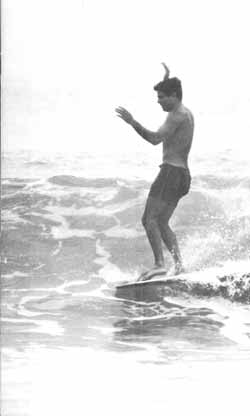 Miki Dora at Malibu - November 1964 issue of Surfguide Magazine - photograph by Leroy Grannis |
|
In July 2001, when I first learned that Miki Dora
was seriously ill, I dismissed the news as just another rumor in a
colorful life plagued by rumor. Besides, it seemed unlikely that a man who
had always radiated such vibrant health could now be fighting for his
life.
Months later, I heard the news again. This time
from an mutual friend who’d known Miki for well over 40 years. This time
I couldn’t dismiss it as idle gossip.
According to my friend, Miki had developed a
rampant form of cancer that ruled out anything but palliative care. He’d
left France, where he’d lived and surfed for much of the past
twenty-five years and was spending what time he had left at his father’s
home in Montecito. He’d come home to die, “as gracefully as
possible.”
|
|
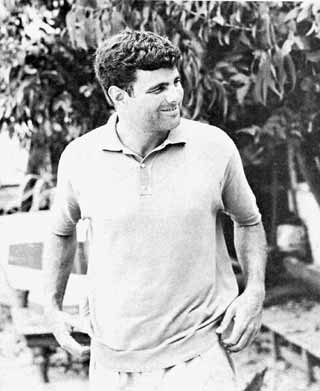 |
As I was rapidly approaching my ‘big-six-oh’,
I’d already had to accept the increasing loss friends and family.
Death comes with the territory and, all too often, one doesn’t get a
second chance to say goodbye. So I decided to write to Miki from my home
in Aotearoa New Zealand.
I know that Miki received a number of visits and
phone calls from old surfing mates over the next couple of months and I
heard that he was moving painfully towards the end of his life with
courage, dignity and humor. I also know that he read my letter.
In it I thanked him for his contribution to my
life by recounting the first time I’d seen him surf and describing the
impact of that experience. Finally, I wished him well on his
“continuing journey,” as that is how I chose to look on the
transition we call ‘death’.
|
Miki at Topanga
Beach circa 1964
Photographer unknown at present, but probably Bill Cleary |
|
“When
there’s surf, I’m totally committed.
When there’s none, it doesn’t exist.”
The first time I saw Miki Dora was a defining
moment in my seventeen year young life and one for which I will always
be grateful.
It was the late 50’s and I’d been surfing
just long enough to feel confident about thinking of myself as a
‘surfer’ and trying to look and act the part as well. In that short
space of time, surfing had become a ‘way-of-life’ for me and just
about everything I did, said, thought or planned revolved around what I
considered to be my ‘sport’.
For a couple of months after I caught my first
wave, I confined my surfing to Point Dume, where I’d learned to stand
up, and Latigo Cove, where my girl friend’s family had their home.
From there I ventured out to all those challenging and diverse North Bay
breaks between Hubbyland and the Lighthouse.
|
|
|
Although I hadn’t yet met Dewey Weber, I was
unconsciously following the advice I’d later hear him offer to other
apprentice surfers: “Learn at a nice right point break and that’s
the only kind of wave you’ll know. Learn at beach breaks, jetties,
points, breakwaters and reef breaks. Take off on every wave that comes
along: lefts, rights, mush, crap, even closeouts. Then you’ll be ready
to ride anything.”
Slowly, by trial and error, I learned how to surf
and started going out at Malibu.
On that particular day I’d walked down past the
‘Wall’ and was squatting up on the cool, dry sand above the tide
line with my board balanced across my lap. It was one of those special
early mornings when the air buzzes with light. A hint of desert in the
light offshore feathered across my bare back and sent raw shivers of
excitement throughout my body.
|
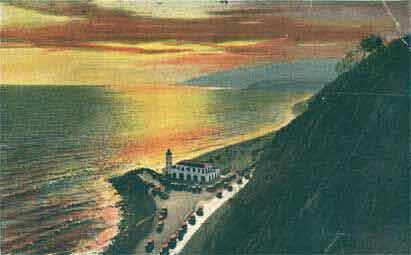 The Lighthouse circa 1930 - now demolished to make way for the box-like building that houses the LA County Lifeguard headquarters. When the rock 'jetty' or groyne seen in this old postcard was extended it created a fast, hard breaking right break that was great - if you made it. |
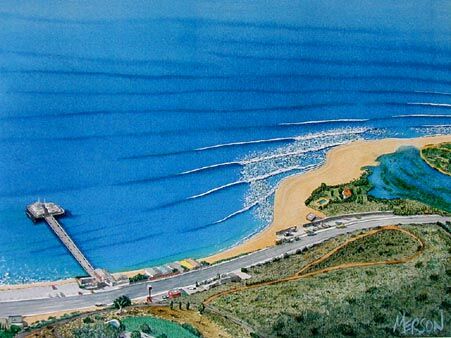 Malibu Morning - painting by Bob Merson. Please click on his name to see more of his work. |
The sun was less than an hour old and there were
already five or six guys out in the water. Another couple were now waxing
up in the ‘Pit’. But Malibu was still new to me and the inshore rocks
sharp and unforgiving. I was content to spend a few more minutes checking
out the waves and wondering about the best place to paddle out.
Suddenly my attention was drawn to a distant figure
taking off on a beautifully shaped shoulder-high wave way out at the
Second Point. It was like becoming aware of a focus of intense energy and
I stood up to get a better look.
|
|
What amazed me at first was that whoever was riding the
wave had made it all the way past the first point and was still going. Then, as
the surfer got closer, his board appeared to be sliding back and forth all on
its own.
Was it the board moving under the surfer, or was it the
surfer moving up and down the board? It was like magic; like watching someone
far more subtle than Michael Jackson doing a barely perceptible ‘Moon Walk’
to stay in perfect trim. The finesse. The control. The pure, unparalleled
artistry.
|
|
|
Up until that moment, I had looked upon surfing as a
sport, and surfers, myself included, as players who competed against each other
to see who was ‘the best’.
With my new friends and acquaintances I’d sit on the
beach or stand around in parking lots judging whoever happened to be surfing at
the time. Every once in a while someone’s ride would be overwhelmingly
acclaimed and the surfer receive a popular accolade such as, “really good.”
But most of our energies were spent on criticizing each other and trying to
convince ourselves how much better we would have done had we been on the wave.
|
|
|
Even now I’m embarrassed to admit that I wanted to be
the guy about whom they’d all say, “Wow! He’s a really good surfer.” I
wanted people to recognize me when I walked onto a beach or into a surfing
movie. I wanted to be respected for my amazing surfing ability and skill. Not
that I had a snowball’s chance in hell of achieving any of this, but that’s
what my seventeen year old intellect thought surfing was all about. I was
surfing to be noticed.
|
|
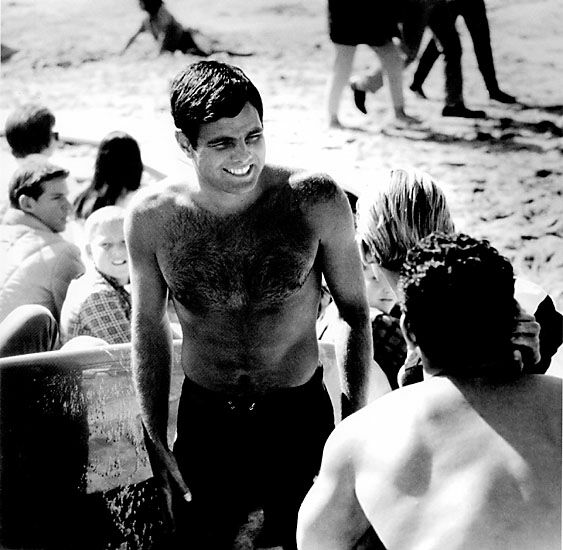 Photograph copied from an internet site was unattributed. Any information would be appreciated. |
In a gradual but very powerful way, seeing Miki Dora on
that single ride changed all that.
Firstly, by opening my eyes to the exquisite beauty and
grace of someone else’s surfing and the tremendous enjoyment that virtuosity
could engender.
Secondly, by planting the seed that eventually grew into
an understanding that surfing was no longer about me and other surfers. It was
about me and the wave. Each wave special. Each wave new. Each wave worthy of my total
commitment and respect.
Surfing was no longer the statement by which I expressed
myself to the world and wished to be recognized in return. It was an absolutely
personal experience that didn’t require an audience or anyone else’s opinion
to validate. Surfing was mine.
|
|
It was Miki who introduced me to the essence of that
passion and solitary joy of surfing. And that has been one of the greatest gifts
of my life.
“Thank
God for a few free waves.”
Bill Cleary also had clear memories of his
first experience of seeing Miki surf at Trestles when Bill was still in the
Marine Corps:
“At the time I fancied myself a
good enough surfer to appreciate the subtle things he was doing out there, but I
really didn’t have a clue. It would be another ten years before I really
understood the subtleties: and that far from being good Mickey Dora was a surfing genius.”*
|
|
|
Bill had one of those “on again, off again”
relationships with Miki that kept everyone guessing whether they where really
friends or really enemies. They’d insult each other in public and laugh about
it later in private.
“When someone is exceptionally
talented, we tend to think of him in terms of extensions of our own abilities.
|
Bill
Cleary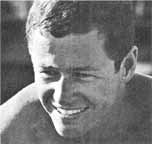 |
|
Those who can multiply ten figure numbers or do square roots in their heads, we
assume to be just like us except that they were born knowing some kind of trick.
Nothing could be farther from the truth. Like a Michelangelo or a Mozart, Mickey
had a heightened sensibility born of something akin to a sixth sense. But that
does not nearly do it justice - no, it was more like Mickey Dora was born with
an invisible organ, some mysterious faculty homologous to a radio tuned to
higher frequencies. The ‘sounds’ that reached Mickey made up a foreign
language - or perhaps they were more like music or a swirl of color, but
whatever they were, these rarefied intimations contained the wave information
Mickey’s brain hungered for, and which enabled him to surf in ways beyond our
imagining.”*
“The
media is impersonal. They care little whether I live or die.
So what? It’s irrelevant. I know what I stand for, and that’s all that’s important.” |
|
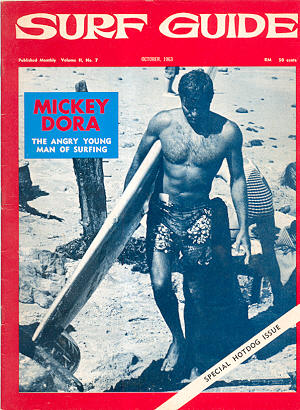 |
While he was editor of sixties surfing magazine, Surfguide,
Bill interviewed Miki for the magazine’s October
1963 issue and later, according to Bill, tricked Miki into giving another interview for
November 1964 "Malibu Issue."
“I gave up trying to talk him
into doing our story the usual way. How could I have ever been so stupid? Mickey
Dora had never done anything in his life “the usual way”, why would he start
now? Instead I rigged a
couple of tape recorders and stashed them out of sight. I wired them into my
answering machine and sat back waiting for Mickey to show up on his own. I
proceeded to interview Lance and Kemp and Morey and Rochlen, knowing word of our
Malibu project was already spreading via the coconut telegraph; and that he
wouldn’t be able to resist. A curious creature, the Cat.”*
Bill’s patience finally paid off:
|
|
“And so it happened. Mickey stopped by one afternoon, we sat outside on the porch, I flicked on the hidden recorders and he took off. I hardly said a word, not wanting to interrupt the flow of Mickey’s classic dialog as he recounted Malibu myth. Fingers flying over the memory beads, he raked through the old stories of Mitch the Masochist, Tubesteak, Gidget, Simmons and Matt Kivlin.
“Listening to the tape later, I
knew I had got exactly what I wanted.
His dialog was perfect. I could print it word-for-word.”*
|
|
|
It is one of the many paradoxes that punctuated Miki Dora’s life that his unconcealed contempt for the surfing media and his unwillingness to share his private thoughts with the surfing public were immortalized by the very medium he despised.
“The
vintage years are over.
I have my memories and that’s it. I want to keep them to myself. I don’t want to share them with a bunch of idiots.”
Bill's Surfguide
interview with Miki had been secretly recorded and, according to Bill, Miki
was furious. Or was he?
In any
event it was followed by other articles, including what some consider an
even more revealing profile Bill did for Surfer when he was the
magazine's associate editor.
|
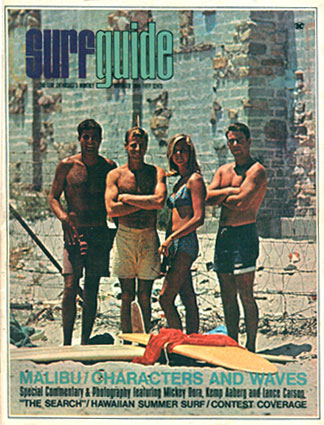 Surfguide's iconic 'Malibu Issue' - November 1964 with Miki Dora, Kemp Aaberg, Mary Sturdevant and Lance Carson |
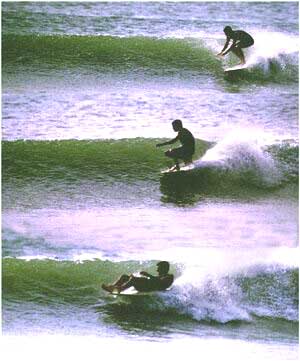 |
“Mickey is not only a genius but
an eccentric one whose personality is so complicated and wound with
contradiction and paradox, that even those closest to him cannot claim to
understand him.”
“One can see everything there is
to see in Mickey Dora when he is surfing.
He is quick, supremely conscious, and he is always the first to know when
the waves are coming and where. His timing and balance defy description. He is
upon occasion even playful out there. He will segué into an impromptu session
of “Quasimodo’s” and “Coffins” and “spinners” or he will simply
surf backwards. For the most part, however, there is no one who takes his
surfing any more seriously than” he does.*
|
| Photos of Miki at Topanga Beach by Bill Cleary |
|
And that is what I will always remember more about Miki
than anything else - his surfing. The way he lived his private life was exactly
that. Private. Whether he was called Mickey or Miki, Chapin or Dora - that was
also his business. It was surfing that defined his life as an artist and to
judge him by any other criterion is to close one’s eyes to the essence of that
art.
In the same way, trying to rank him amongst the pantheon
of surfing greats or comparing him with other artists, such as Phil Edwards or
Kelly Slater would be like trying to compare Nureyev with Baryshnikov. Miki was
in a league all his own.
“Life
is passing time
as gracefully as possible.” |
|
|
Duke Kahanamoku
presenting Miki with a trophy
at the 1967 Duke Contest - photography by Leroy Grannis |
|
“In surfing as in his life,
Mickey Dora has made up his own game, plays it by his own rules, harvests his
own rewards. Nobody understands him. Even those intelligent enough to relate
seldom grasp what he is saying and doing - because the Cat never lets anyone get
too close. He is good at what he does, and he does it with grace and style.
That’s enough for me. People like him should granted special status. Maybe
they should be turned into national parks. At the very least they should be left
alone.” *
|
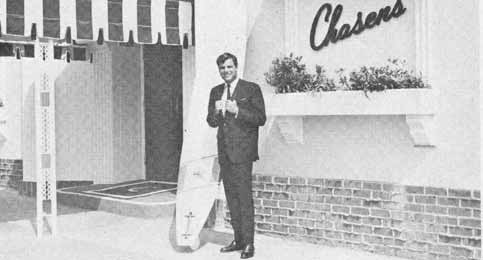 Miki outside Chasens Restaurant with his Morey Surfboard in a photo taken for the 'Malibu Issue' of Surfguide Magazine, November 1964 |
||
|
Left alone to dance with the waves. That doesn’t seem
like all that much to afford an artist of Miki’s eminence. In fact, up until
shortly after I first saw him surf he enjoyed exactly that kind of freedom. But
when things changed it happened quickly and irrevocably. Surfing’s new
generation had little respect for subtleties, art or tradition. All but a few
were “surfing to be noticed” and, like swarms of moths, drawn to nearest
flicker of flame rather than the distant glow of the moon.
I’ve always thought that it must be have been
mixed-blessing that a master such as Miki was only whole when he was in total
communion with his art. But to suddenly have to share the stage with tradesmen,
apprentices and rank amateurs must have been frustrating to the extreme.
It seemed like his frustration turned to a bitterness
that grew in direct proportion to the increasing popularity of surfing itself.
So it didn’t surprise me to learn that he was becoming even more reclusive and
spending his time traveling the world in search of unsullied waves. I was just
sorry that I wouldn’t see him surf again and when he turned up one day in
Gisborne, New Zealand (where I’d temporarily settled during my own search), I
was pleased to learn that he’d been successful in his quest.
Of the last 25 years of Miki’s life I know little
except that he was once again able to enjoy that precious, inviolable communion.
May his soul continue to surf joyfully in the hand of God.
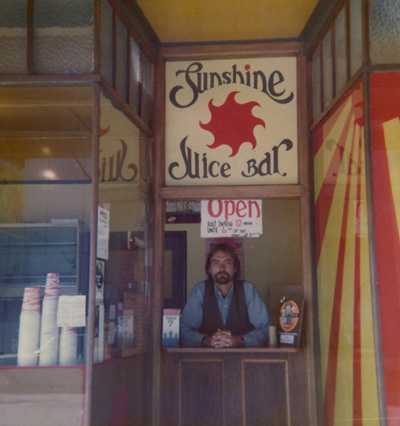 Me at the juice bar, Gisborne, New Zealand circa 1975. Sign reads, "Open just before 12 noon until 6pm or so ..." Surfer's hours. Miki walked up one day out of the blue and asked me what was in a smoothie. I answered, "Milk, banana and honey plus anything else you'd like me to add, like fruit, yeast, eggs, carob, protein powder and so on." Miki said he didn't drink milk and didn't eat honey. "Can you make me a smoothie without milk and honey?" So I whipped him up a smoothie made with freshly made apple juice, banana and raspberries, and he said I could call it a "Smoothie a la Miki" if I wanted.
In
celebration of an artist and his art
© Robert R. Feigel, 2001, 2002 - All
rights reserved
*From:
‘Nine Lives of Da Cat’ - part of an unpublished selection of short stories
titled “Surf
Songs,”
by William Cleary © 1998-99
MIKLOS DORA - AUGUST 11, 1934 to JANUARY 3, 2002 |
|||
| From
a tribute photo published on the internet by BK (aka Big
Kook) shortly after Miki Dora passed on - photographer of the original photos on wall unnamed. Click on photo to link to Memories of a Wavemaster - Saltwater Damage. 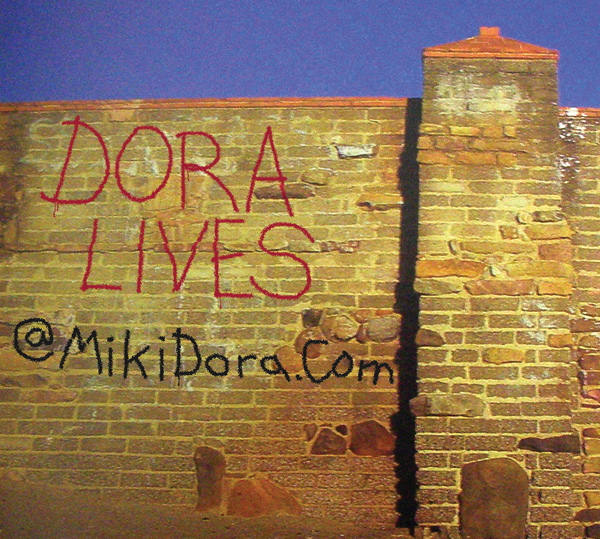 Click this link for an article about what happened to Miki's trophy from the 1967 Duke contest as well as a virtual treasure trove of his other memorabilia. Please visit MikiDora.Com and visit our Facebook Page read the review: ALL FOR A FEW PERFECT WAVES The Audacious Life and Legend of Rebel Surfer: MIKI DORA http://www.surfwriter.net/mikis_tribute.htm | |||

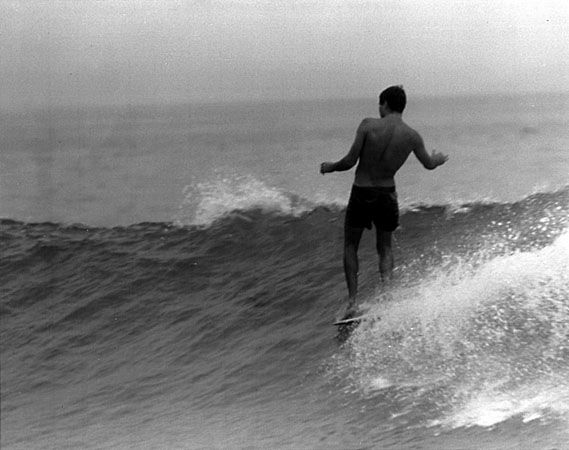
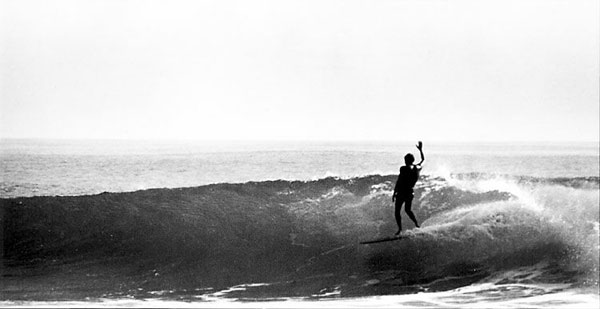
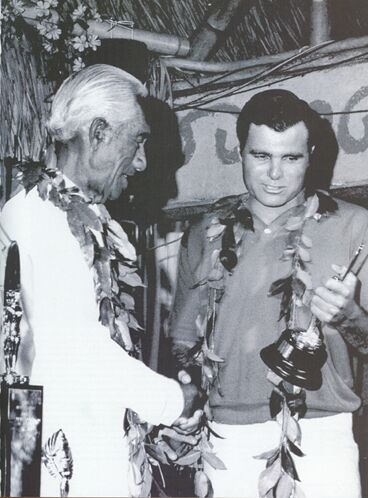
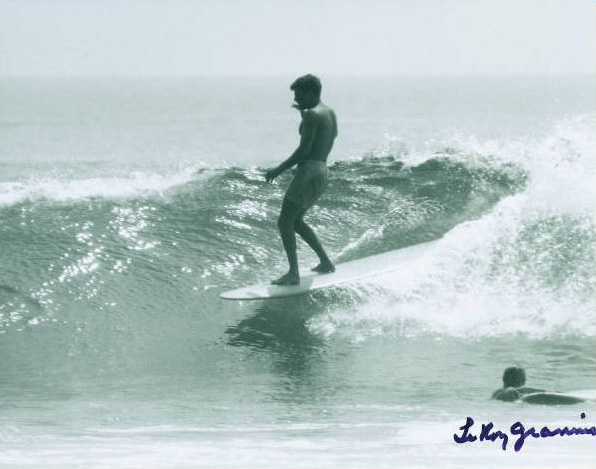
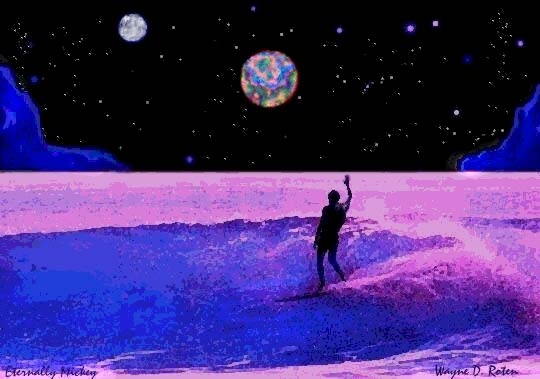
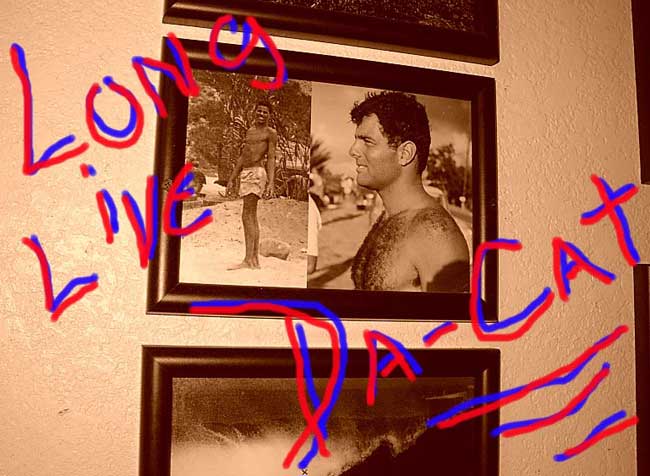
No hay comentarios:
Publicar un comentario